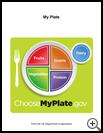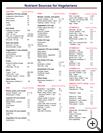
Vegetarian Diet
What is a vegetarian diet?
A vegetarian diet does not include meat. Vegetarians do not eat meat, poultry, or fish. Many vegetarians also avoid other animal products such as gelatin, rennet (used to make some kinds of cheese), and animal fats. Vegetarians who eat eggs and dairy products are called ovo-lacto vegetarians. People who avoid all animal products are called vegans.
A well-planned vegetarian diet can be good for health. By not eating meat, your child eats less cholesterol and less saturated fat. This may lower the risk of heart disease, gallstones, stroke, and some types of cancer.
Will my child get all of the nutrients he needs?
All of the rules for a healthy diet are true for a vegetarian diet. Your child needs to eat a variety of foods in the right amounts. You may have to work harder to provide all of the nutrients your child needs if your family eats no animal products at all.
A well planned vegetarian diet is safe. If it is too low in protein or other nutrients, or too high in sweets, sodas, and snack foods, it may be unhealthy.
Younger children often have smaller appetites. High fiber plant foods have fewer calories and are more filling. Your child may get full before getting enough calories. It helps to serve frequent meals and snacks. Choose foods with higher fat content (healthy unsaturated fats) to help your child with energy and nutrient needs.
Here are some of the nutrients you need to be sure that your child gets.
- Calcium: Milk products are one of the best sources of calcium. Calcium is also in many other foods such as broccoli, kale, beans, and soy. However, the calcium in these foods is not absorbed as well as the calcium in milk products. Calcium has been added to some foods (fortified), which makes it easier to meet daily calcium needs, but it still can be hard for your child’s body to get enough calcium if dairy foods are not a part of his diet. Ask your healthcare provider if your child should take calcium supplements, and which kind he should take.
- Iron: Plant foods high in iron include beans, lentils, spinach, and Swiss chard. It’s harder for the body to absorb iron from plants than from meat, poultry, and fish. Serve foods that contain vitamin C, such as citrus fruits, broccoli, and tomatoes, when your family eats plant foods that have iron. Eating these foods together helps the body to absorb the iron better.
- Zinc: Zinc is not as easy for the body to absorb from plant foods as it is from animal products. Because of this, your child may need to eat more zinc than people who eat meat. Good sources of zinc include whole grains, breads and fortified cereals, nuts and dried beans.
- Vitamin B-2: Vitamin B2, or riboflavin, is found in green vegetables such as asparagus and broccoli. However, vegetables do not have as much vitamin B2 as milk products, eggs, and meat. Your child may need a supplement to get all the vitamin B2 that the body needs.
- Vitamin B-6: Also known as pyridoxine, vitamin B-6 is found in peas, beans, lentils, bananas, and fortified breads and cereals. Vegetarians usually get enough of this vitamin from their diet.
- Vitamin B-12: Vitamin B-12 is found naturally in animal products such as fish, liver, eggs, and dairy. When you read food labels, look for the words cyanocobalamin or cobalamin in the ingredient list. These are the forms of Vitamin B-12 that are most easily absorbed.
- Vitamin D: Vitamin D is added to soy, rice, and almond milk, yogurt, some cereals, and juices. The food label will tell you if a food is fortified with Vitamin D. Skin makes vitamin D when it is exposed to sunshine, so your child should spend some time outdoors. Ask your healthcare provider if your child should take a vitamin D supplement to make sure that he is getting enough.
- Omega-3 fatty acids: Plant foods high in linolenic acid (omega 3) are flaxseed and flaxseed oil, chia seeds, canola oil, walnuts, seaweed, soybeans, and soybean oil. Some margarines and nondairy milks are now fortified with omega-3s. Your child can also take vegan supplements made from algae.
- Protein: There are many plant sources of protein, such as beans, nuts, seeds, soy, quinoa, pea hemp, and others. Be sure to read labels and eat a variety of foods to get the right mix of proteins.
If I am breastfeeding, will my breast milk be healthy for my baby?
If you get enough nutrients from whole grains, fruits, vegetables, beans, nuts, seeds, and oils, you and your baby can have a healthy diet. Make sure that you get enough zinc, iron, vitamin B-12, and vitamin D. Your healthcare provider may tell you to keep taking prenatal vitamins while breastfeeding.
Breastfed babies should also take a vitamin D supplement. You can buy liquid multivitamin drops with vitamin D without a prescription. Ask your provider for a recommendation.
Breastfed babies who are 4 to 6 months old and not yet getting solid food should take supplements of iron. This needed iron is provided by infant cereals when you start feeding your baby solid foods.
How do I know if my child is eating a healthy diet?
One of the best ways to check if your child is eating well is to track your child's weight and height. If your child is not getting enough nutrients, his or her height and weight will not follow the usual growth patterns for children. Your healthcare provider checks your child's growth on a growth chart.
If your child is not getting enough vitamins or minerals, he may have symptoms such as:
- Rashes
- A painful, swollen tongue and swollen gums
- Tiredness
- Irritability
- Depression
- Pale skin
- Trouble focusing
- Poor growth or slow weight gain
Check with your healthcare provider if you think your child may not be getting all the nutrients he needs.
Where can I get more information?
You can get more information from:
- The Vegetarian Resource Group
http://www.vrg.org/ - USDA ChooseMyPlate
https://www.choosemyplate.gov/ - Academy of Nutrition and Dietetics
http://www.eatright.org
Last modified: 2016-10-18
Last reviewed: 2016-05-11


